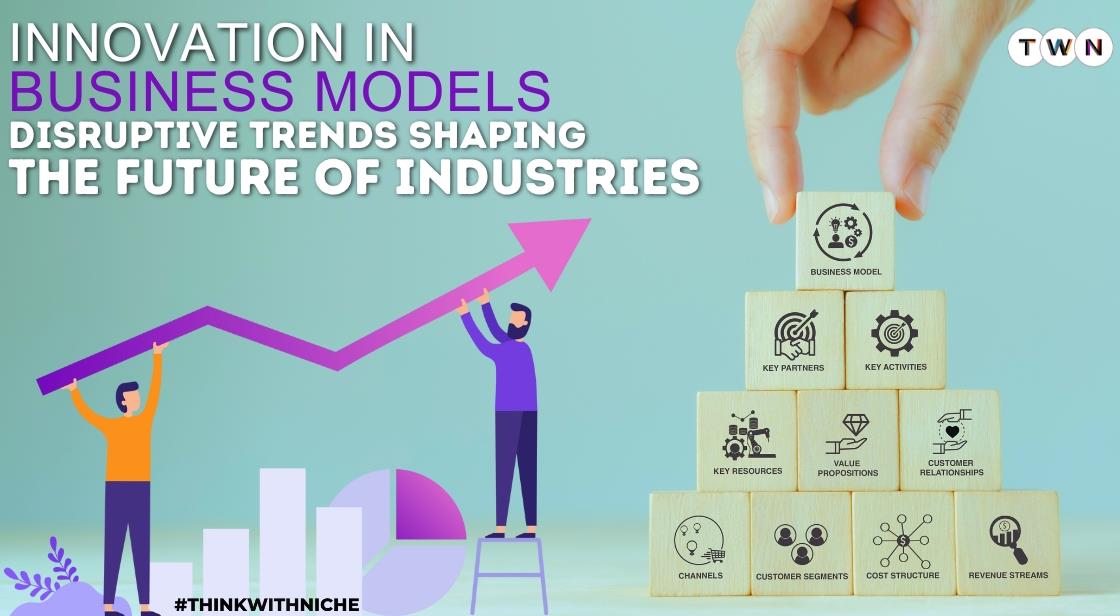Innovation in Business Models: Disruptive Trends Shaping the Future of Industries

Blog Post
In today's dynamic business landscape, innovation in business models has emerged as a critical determinant of success and sustainability. Traditional approaches to value creation and delivery are being challenged by disruptive trends reshaping industries across the globe.
From technological advancements to shifting consumer behaviors, a myriad of factors is driving the evolution of business models, compelling organizations to adapt or risk obsolescence.
At the heart of this transformation lies the imperative to rethink how value is conceptualized, captured, and delivered to customers. Disruptive trends such as digitalization, globalization, and sustainability are reshaping the fundamental dynamics of industries, prompting businesses to explore new avenues for differentiation and competitive advantage.
Digitalization has democratized access to markets and information, empowering consumers and enabling new forms of interaction and engagement. As a result, traditional business models built around physical assets and linear value chains are being disrupted by digital platforms and ecosystems that thrive on connectivity and data-driven insights.
Globalization has facilitated the integration of markets and supply chains, opening up opportunities for collaboration and expansion into new territories. However, it has also intensified competition and accelerated the pace of change, necessitating agility and adaptability in business models to stay ahead of the curve.
Moreover, the growing emphasis on sustainability and corporate responsibility is driving a shift towards business models that prioritize environmental and social impact alongside financial performance. From circular economy principles to shared value creation, organizations are exploring innovative ways to align profit with purpose and address pressing societal challenges.
In this dynamic landscape, understanding and harnessing disruptive trends are essential for organizations seeking to thrive in the future. By embracing innovation in business models, companies can unlock new sources of value, drive growth, and shape the future of industries in a rapidly evolving world.
Unveiling Business Revolution: Disruptive Trends Reshaping Industries
1. Innovation in Business Models: Disruptive Trends
Redefining Business Landscapes:
Innovation in business models refers to the introduction of new strategies, methods, or approaches that challenge traditional norms and reshape the way industries operate. These innovations often stem from emerging technologies, changing consumer behaviors, and evolving market dynamics.
Embracing Digital Transformation:
One of the key disruptive trends in business models is the widespread adoption of digital transformation. Companies are leveraging digital technologies such as artificial intelligence, big data analytics, and cloud computing to streamline operations, enhance customer experiences, and create new revenue streams.
Shift Towards Subscription-Based Models:
Another prominent trend is the shift towards subscription-based business models. From streaming services to software as a service (SaaS) platforms, companies are offering subscription-based solutions that provide recurring revenue streams while offering customers flexibility and convenience.
Exploring Platform Economies:
Platform economies have emerged as a dominant force in various industries. Companies like Uber, Airbnb, and Amazon have created platforms that connect buyers and sellers, service providers, and consumers, disrupting traditional business models and redefining value chains.
Adoption of Agile Business Strategies:
Agile business strategies have become essential for organizations looking to thrive in today's fast-paced and unpredictable market environments. By embracing agility, companies can quickly respond to changing customer needs, market trends, and competitive pressures, enabling them to stay ahead of the curve.
2. Rethinking Traditional Approaches:
In today's rapidly evolving business landscape, organizations are increasingly recognizing the need to reassess and adapt their traditional approaches to stay competitive and relevant. This involves challenging conventional methods and embracing innovative strategies to meet the changing demands of the market.
Understanding the Need for Change:
Traditional approaches often rely on established practices and frameworks that may no longer be effective in the face of evolving consumer preferences, technological advancements, and market dynamics. Recognizing the limitations of these traditional methods is the first step towards rethinking and revamping them.
Embracing Agility and Flexibility:
One key aspect of rethinking traditional approaches is the adoption of agile and flexible methodologies. This involves fostering a culture of innovation and adaptability within the organization, allowing for quicker responses to market shifts and customer needs. Agile methodologies empower teams to iterate rapidly, test new ideas, and make timely adjustments to strategies and processes.
Harnessing Technology and Innovation:
Technology plays a crucial role in redefining traditional approaches. By leveraging cutting-edge technologies such as artificial intelligence, machine learning, and automation, businesses can streamline operations, enhance productivity, and deliver superior products and services to customers. Embracing innovation allows organizations to stay ahead of the curve and drive sustainable growth in an increasingly digital world.
Empowering Employees and Encouraging Collaboration:
Rethinking traditional approaches also involves empowering employees to think creatively, take calculated risks, and contribute to organizational innovation. Encouraging collaboration across departments and fostering a culture of open communication enables cross-functional teams to work together towards common goals, driving innovation and driving the organization forward.
3. Embracing Digital Transformation
Organizations that want to stay relevant and competitive in the ever changing business landscape of today must embrace digital transformation. This strategic shift entails the integration of digital technologies into all aspects of business operations, fundamentally altering how companies operate and deliver value to customers.
Enhanced Efficiency and Productivity:
Digital transformation streamlines processes, eliminates manual tasks, and enhances operational efficiency. By automating repetitive tasks and workflows, organizations can allocate resources more effectively and drive productivity gains across departments.
Improved Customer Experience:
Digital transformation facilitates firms in providing customers with seamless and personalized experiences.Through data analytics and AI-driven insights, companies can gain a deeper understanding of customer preferences, behavior, and pain points, allowing them to tailor products, services, and interactions accordingly.
Agile and Data-Driven Decision-Making:
Digital transformation empowers organizations to make data-driven decisions in real-time. By harnessing the power of big data analytics, companies can gain actionable insights into market trends, customer behavior, and emerging opportunities, enabling agile decision-making and strategic planning.
Innovation and Competitive Advantage:
Digital transformation fosters a culture of innovation, enabling organizations to experiment with new technologies, business models, and value propositions. By embracing innovation, companies can differentiate themselves from competitors, drive market disruption, and seize new growth opportunities.
Flexible Work Environments:
Digital transformation facilitates remote work and collaboration, enabling employees to work from anywhere, anytime. Cloud-based tools, virtual communication platforms, and collaboration software empower teams to collaborate effectively, regardless of geographical location, fostering a more flexible and agile workforce.
Challenges and Considerations:
While digital transformation offers numerous benefits, it also presents challenges such as cybersecurity risks, legacy system integration, and workforce reskilling. Organizations must address these challenges proactively and invest in robust cybersecurity measures, legacy system modernization, and employee training to ensure a smooth transition to a digitally-driven future.
Also Read: Must-Read Business Books for Building Your Dream Business
4. Leveraging Data Analytics for Competitive Edge
In today's data-driven business landscape, leveraging data analytics has become imperative for gaining a competitive edge. By harnessing the power of data analytics, businesses can extract valuable insights from vast amounts of data, enabling informed decision-making and strategic planning.
Data Collection and Aggregation
The first step in leveraging data analytics involves collecting and aggregating data from various sources, including internal databases, customer interactions, social media, and IoT devices. This data encompasses structured and unstructured data, providing a comprehensive view of business operations and customer behavior.
Data Processing and Analysis
Once the data is collected, it undergoes processing and analysis to uncover meaningful patterns, trends, and correlations. Advanced analytics techniques such as predictive modeling, machine learning, and artificial intelligence are utilized to extract actionable insights from the data. This analysis helps identify opportunities, mitigate risks, and optimize business processes.
Customer Segmentation and Personalization
Data analytics enables businesses to segment their customer base into distinct groups based on demographics, behavior, preferences, and purchasing patterns. By understanding customer segments, businesses can tailor their products, services, and marketing strategies to meet specific needs and preferences, enhancing customer satisfaction and loyalty.
Operational Efficiency and Performance Optimization
Data analytics also plays a crucial role in enhancing operational efficiency and performance optimization. Businesses are better able to find bottlenecks, optimize workflows, and distribute resources by examining operational data. This results in cost savings, improved productivity, and better resource utilization.
5. The Rise of Subscription-Based Models
Subscription-based models have witnessed a remarkable surge across various industries in recent years, fundamentally altering the way consumers access products and services. This paradigm shift is driven by evolving consumer preferences, technological advancements, and the need for businesses to ensure recurring revenue streams.
Key Drivers:
-
Convenience: Subscriptions offer consumers hassle-free access to products and services without the need for repetitive purchasing or commitments.
-
Cost-effectiveness: Many subscription models provide cost savings compared to traditional purchasing methods, especially for frequently used services like streaming platforms or software.
-
Personalization: Companies leverage subscription data to tailor offerings to individual preferences, enhancing the overall customer experience.
-
Predictable Revenue: Subscription-based models provide businesses with predictable and steady revenue streams, facilitating better financial planning and stability.
Industry Adoption:
-
Media and Entertainment: Streaming services like Netflix, Spotify, and Disney+ have pioneered subscription-based models in the entertainment industry, revolutionizing content consumption.
-
Software as a Service (SaaS): SaaS companies offer subscription-based access to software applications, catering to businesses' needs for scalable and flexible solutions.
-
Retail: Subscription boxes have gained popularity, offering curated products delivered directly to consumers' doorsteps on a regular basis.
Challenges and Opportunities:
-
Customer Retention: Maintaining subscriber loyalty amidst increasing competition poses a challenge, emphasizing the importance of continuously delivering value.
-
Market Saturation: As subscription offerings proliferate, companies must differentiate their offerings to stand out in a crowded market.
-
Data Security and Privacy: Collecting and managing subscriber data necessitates robust security measures to safeguard sensitive information and maintain trust.
6. Sustainable Business Practices: A New Norm
In recent years, there has been a noticeable shift towards sustainable business practices, driven by increasing environmental awareness, regulatory pressures, and changing consumer preferences. This trend marks a significant departure from traditional business models focused solely on profit maximization, emphasizing the importance of environmental and social responsibility alongside economic success.
Environmental Sustainability:
One of the key pillars of sustainable business practices is environmental sustainability. This involves minimizing the negative impact of business operations on the environment by reducing carbon emissions, conserving resources, and adopting renewable energy sources. Companies are increasingly implementing eco-friendly initiatives such as waste reduction, energy-efficient technologies, and sustainable supply chain management to mitigate their ecological footprint.
Social Responsibility:
Another crucial aspect of sustainable business practices is social responsibility. This entails considering the well-being of all stakeholders, including employees, communities, and society at large. Companies are embracing ethical labor practices, promoting diversity and inclusion, and investing in community development programs. By prioritizing social responsibility, businesses can enhance their reputation, build trust with stakeholders, and contribute positively to society.
Economic Viability:
While environmental and social considerations are paramount, sustainable business practices also prioritize economic viability. Companies recognize that long-term profitability depends on resilience and adaptability in the face of environmental and social challenges.
By integrating sustainability into their core business strategies, organizations can identify cost-saving opportunities, access new markets, and foster innovation, thus ensuring their continued success in a rapidly changing world.
7. Navigating Disruption: Agile Business Strategies
In today's rapidly evolving business landscape, disruption is inevitable. From technological advancements to global crises, businesses face constant challenges that can upend traditional operations. To thrive in this environment, organizations must adopt agile business strategies that enable them to adapt quickly and effectively.
Here's an overview of navigating disruption through agile strategies:
Understanding Disruption:
Disruption refers to significant changes in the market or industry that can alter the competitive landscape. This could be driven by technological innovation, shifts in consumer behavior, regulatory changes, or unforeseen events like pandemics or natural disasters.
The Importance of Agility:
Agility is the ability of an organization to respond swiftly and flexibly to changes in the environment. In the face of disruption, businesses that are agile can adjust their strategies, processes, and resources to capitalize on emerging opportunities or mitigate risks.
Key Components of Agile Business Strategies:
Agile business strategies involve several key components, including:
-
Flexibility: Embracing flexibility in decision-making, resource allocation, and operational processes allows businesses to pivot quickly in response to disruption.
-
Innovation: Fostering a culture of innovation encourages the exploration of new ideas and solutions to address emerging challenges or capitalize on market opportunities.
-
Collaboration: Collaboration both internally and externally enables businesses to leverage diverse perspectives and expertise to adapt to changing circumstances effectively.
-
Iterative Approach: Adopting an iterative approach to strategy and execution allows businesses to test and learn from their efforts, making continuous improvements over time.
Implementing Agile Strategies:
Implementing agile strategies requires a commitment from leadership to embrace change, invest in technology and talent, and empower employees to take calculated risks and innovate.
8. The Impact of Artificial Intelligence and Automation
Artificial Intelligence (AI) and automation have emerged as transformative forces, reshaping various aspects of society, economy, and daily life. Their impact is multifaceted, spanning industries, employment, and societal structures.
Economic Transformation:
Automation and artificial intelligence are transforming industries, optimizing workflows, and raising output. Businesses are adopting AI-powered solutions for tasks ranging from customer service to supply chain management. This transformation fosters economic growth and competitiveness, but also poses challenges such as workforce displacement and skill gaps.
Employment Dynamics:
While AI and automation create new job opportunities, they also disrupt traditional roles. Routine tasks are increasingly automated, leading to concerns about job displacement and unemployment. However, AI also generates demand for skilled workers proficient in data analysis, machine learning, and AI development.
Social Implications:
The widespread adoption of AI and automation raises ethical and societal concerns. Issues like data privacy, algorithmic bias, and job insecurity provoke debates about regulation and governance. Additionally, disparities in access to AI technologies deepen existing inequalities, necessitating inclusive policies and initiatives.
Human-Machine Collaboration:
An emerging paradigm is human-machine collaboration, where AI augments human capabilities rather than replacing them. This approach enhances efficiency and innovation across sectors like healthcare, finance, and manufacturing. However, it requires redefining roles, fostering digital literacy, and ensuring ethical AI deployment.
Future Outlook:
As AI and automation continue to evolve, their impact will intensify. Anticipating future developments is crucial for policymakers, businesses, and individuals to navigate the opportunities and challenges effectively.
Embracing lifelong learning, fostering innovation, and prioritizing ethical considerations will be essential for harnessing the full potential of AI and automation while mitigating adverse effects.
9. Enhancing Customer Experience Through Personalization
In today's competitive business landscape, delivering exceptional customer experiences is paramount for sustaining success. Personalization has emerged as a key strategy for businesses to connect with their customers on a deeper level, anticipate their needs, and foster long-term loyalty.
Understanding Customer Needs:
Understanding each customer's particular demands, tastes, and habits is the first step towards personalization. By leveraging data analytics and customer insights, businesses can gain valuable knowledge about their target audience and tailor their offerings accordingly.
Customized Products and Services:
Personalization enables businesses to create customized products and services that resonate with the specific requirements of each customer. Whether it's recommending relevant products based on past purchases or offering personalized promotions, customization enhances the overall customer experience and increases satisfaction.
Tailored Communication:
Building solid connections with consumers requires effective communication. Personalization allows businesses to communicate with customers in a tailored manner, addressing their interests and concerns directly.
Whether through personalized emails, targeted advertisements, or interactive chatbots, personalized communication reinforces the sense of being valued and understood.
Seamless Omni-channel Experience:
In today's omnichannel environment, customers expect a seamless experience across various touchpoints, including websites, mobile apps, social media, and physical stores. Personalization ensures consistency and coherence across these channels, allowing customers to pick up where they left off regardless of the platform they choose to engage with.
Building Emotional Connections:
Beyond meeting functional needs, personalization helps businesses build emotional connections with customers. By showing genuine interest and empathy, businesses can foster trust and loyalty, turning customers into brand advocates who are more likely to recommend the brand to others.
10. Collaboration and Partnerships: Driving Innovation
Collaboration and partnerships are indispensable drivers of innovation in today's interconnected world. By bringing together diverse expertise, resources, and perspectives, these alliances create fertile ground for groundbreaking ideas and solutions.
Fostering Creativity and Diverse Perspectives:
Collaboration breaks down silos and fosters creativity by enabling cross-pollination of ideas from individuals with varied backgrounds and expertise. Partnerships bring together stakeholders from different industries, disciplines, and cultures, encouraging the exploration of unconventional approaches and perspectives. This diversity stimulates innovation by challenging conventional thinking and fostering the emergence of novel solutions.
Pooling Resources and Expertise:
Partnerships allow organizations to pool resources, whether it be financial, intellectual, or technological, amplifying their capacity to tackle complex challenges. By combining complementary strengths, partners can leverage each other's expertise and infrastructure to accelerate the development and deployment of innovative products, services, or processes. This collaborative approach enables more efficient allocation of resources and mitigates risks associated with innovation.
Expanding Market Reach and Opportunities:
Collaborative ventures provide access to new markets, customer segments, and distribution channels that may have been inaccessible otherwise. By partnering with organizations possessing complementary market presence or customer bases, businesses can expand their reach and capitalize on new growth opportunities.
These partnerships not only enhance market penetration but also facilitate the co-creation of value propositions tailored to specific market needs and preferences.
Driving Social Impact and Sustainability:
Collaboration and partnerships play a vital role in driving social impact and sustainability initiatives. By aligning interests and pooling resources, organizations can address pressing societal challenges, such as climate change, poverty alleviation, and healthcare access.
Collaborative efforts enable the development of innovative solutions that balance economic viability with social and environmental responsibility, thereby fostering sustainable development and societal progress.
You May Like
EDITOR’S CHOICE












